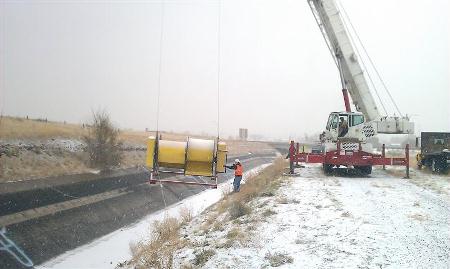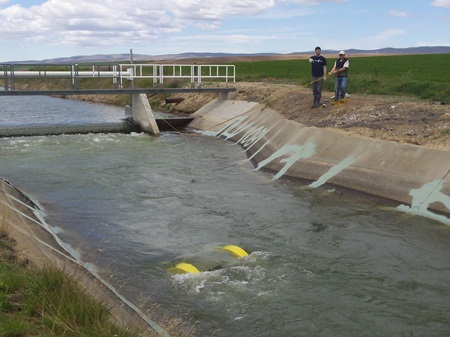Hydrovolts is a Seattle, Washington-based startup with an innovative micro-hydro turbine technology. Instead of relying on natural water resources, the Hydrovolts turbine is designed specifically for use in man-made waterways, such as irrigation canals, water diversion channels, discharge channels for wastewater, cooling water discharges from thermal power plants and large hydropower projects.
The company was a global finalist in the 2009 CleanTech Open, and winner of that year’s National Sustainability Award. It also won the CleanTech Open Sustainability Award for the Northwest Region in 2010. This year, Hydrovolts was recognized as a Global Innovator by launch.org, a business mentoring program sponsored by NASA, USAID, the U.S. Department of State and Nike. The company also won the ImagineH2O Water-Energy Nexus Business Plan Competition.

EarthTechling recently sat down with Hydrovolts Founder and CEO Burt Hamner at Hydrovolts’ office in the McKinstry Innovation Center in Seattle’s SODO district.
Hamner first got the idea for Hydrovolts while working on a feasibility study for a proposed tidal power plant in the Tacoma Narrows region of Puget Sound in 2007. Ultimately, the report concluded that a commercial tidal power plant was not technically or economically feasible. But the study did inspire Hamner to explore the possibility of generating power in smaller, artificial water channels. Unlike Puget Sound, “these canals generally have steady, predictable currents, contain little or no debris, have no endangered species, and are easily accessible by road,” he said. “They are also typically maintained by large engineering organizations that know how to handle machinery.”
Hydrovolts was born from Hamner’s desire to develop a “plug and play,” drop-in micro-hydro turbine that requires no concrete or construction, and utilizes commercial off-the-shelf components. The turbine features a “flipwing” rotor, which uses hinged blades to rotate the center turbine shaft. As the blades begin their reverse upstream stroke, they flip open backwards to eliminate resistance (see video below).
The company offers three different blade designs, which can be switched out to accommodate different current levels and applications. The turbine itself also comes in three different sizes, capable of producing 100w to 16kW, depending on water velocity. The smallest model is about the size of a two-drawer filing cabinet, and can be installed by two people in less than an hour. The largest model fits inside of a standard shipping container.
The simplicity of Hydrovolts’ technology has been central to its initial success, Hamner said. “We have the benefit of having a technology that is simple for everybody to understand. It’s obvious that it works–you can see it spin. If it works in one water canal, it will work in all of them.”
According to Hamner, Hydrovolts’ technology has only recently become cost-effective, due to technological advances in small wind turbine generators and micro-inverters. In many states, including Washington, micro-hydro turbines do not even qualify as renewable resources under the state’s Renewable Portfolio Standard (RPS).
But, Hamner believes that micro-hydro in artificial water systems is an untapped, cheap distributed energy resource that can stand on its own without renewable energy incentives. When properly sited, Hydrovolts’ turbine is priced to pay for itself within five years. “The [turbines] simply make inexpensive power,” he said. “There are a million-plus miles of suitable canals out there. It’s like the world is covered in highways of water, and we just invented the first car.”

In addition to net metering and battery charging, Hamner envisions the technology being used for irrigation. “Most canal systems cover large dry areas of the world,” he said. “These areas are home to billions of rural people who live on subsistence farming. The turbines will make it possible to not only have clean energy suitable to powering a village, but they can also simply pump water out of the canals to create fertile farmland. The impact is not just on renewable energy, but also on new food production.”
Hydrovolts currently has four turbines operating in the field. An additional turbine is currently being installed to power Christmas lights at the wastewater treatment plant in Port Orchard, Washington. The company will soon begin formal field testing at a U.S. Bureau of Reclamation canal in Yakima, Washington as well.
I asked Burt if, as an entrepreneur, he had any advice for other people who think they might have a good clean-tech business idea. “I encourage other people to get into an incubator environment as fast as you can because it’s difficult to create a business when you’re working in your house or some cheap office,” he said. “Being [at the McKinstry Innovation Center] gives us access to manufacturing services, grantwriting, financing and so much more. The other thing I can recommend is to participate in business plan competitions. When we first started out, we were just two guys with a big idea and a small scale model. We entered every business contest we could get into and that’s help fund the company–we have won over $200,000 in cash and services… But, even if you don’t win, the mentoring resources are invaluable.”